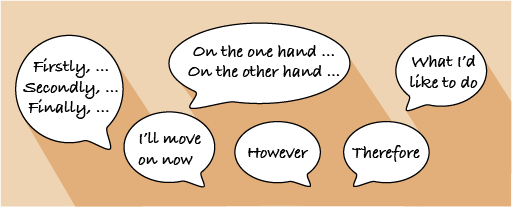4.4 Markers and signposts
If you have a lot of information to get across in a talk, you might need to make your structure even clearer to your listeners. You can do this by using markers or signposts in the main part of your talk.
These are words that show listeners where the conversation or presentation is going.
For example, for the talk in the previous activity, you might start like this:
‘I am going to talk about the centre in three sections. Firstly, the whereabouts of the centre and opening times; secondly, the programme of events and activities; and, finally, the staff at the centre.’
This tells the listener what to listen out for in the main body of the talk. ‘Firstly’, ‘secondly’ and ‘finally’ become markers for them to follow.
Other marker words include:
- on the one hand
- on the other hand
- whereas
- nevertheless
- even so
- however
- therefore.
Activity 18 Identifying markers and signposts
Listen carefully to the audio, which is a conversation between a doctor and a patient called Lorna. Pause it when you hear either of the speakers using a marker or signpost. Make a note of the word(s) and how they help you to follow the discussion.
Transcript
Discussion
Here are the markers and signposts you may have spotted.
| Who said what | How it helped |
|---|---|
| Doctor: ‘Right. As you know, ...’ | Shows the doctor is ready to start to explain things. |
| Doctor: ‘Quite. Well, ...’ | Shows the doctor is ready to move on. |
| Doctor: ‘I have the results here and what I’d like to do is ...’ | Indicates that the doctor is about to explain what he is going to do. |
| Lorna: ‘Oh, I see.’ | Lorna shows she has heard what the doctor said and is ready for him to continue. |
| Doctor: ‘OK.’ | The doctor shows he has heard what Lorna has just said and is going to respond to her concerns. |
| Doctor: ‘I can see that you’re looking anxious, so ...’ | The doctor acknowledges that his patient is anxious, so he’ll move on to address her fears. |
| Doctor: ‘Firstly, ... Secondly, ...’ | The doctor shows he is going to make a number of points; here is the first … and now the second ... |
| Doctor: ‘If I could move on to explain a little about migraines, ...’ | The doctor shows he’s moving on to talk about something else. |

